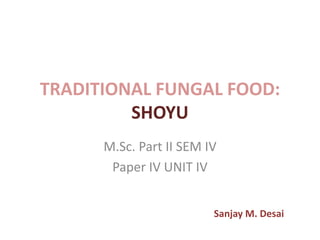
Traditional Shoju Fermentation
- 1. TRADITIONAL FUNGAL FOOD: SHOYU M.Sc. Part II SEM IV Paper IV UNIT IV Sanjay M. Desai
- 3. Outline of koikuchi fermentation (after Yokotsuka, 1981)
- 5. Introduction • Soy sauce , also spelled as soya sauce is a liquid condiment of Chinese origin, traditionally made from a fermented paste of soybeans, roasted grain, brine, and Aspergillus oryzae or Aspergillus sojae molds. • Soy sauce in its current form was created about 2,200 years ago in ancient China, • Spread throughout East and Southeast Asia where it is used in cooking and as a condiment.
- 6. Introduction Historical Aspect: Originally, a common Japanese condiment was uoshōyu, which was fish based.[15] When Buddhism came to Japan from China in the 7th century,[16] they introduced vegetarianism and brought many soy based products with them, such as soya sauce,[15] which is known as shōyu[17][9] in Japan. Shoyu exportation began in 1647 by the Dutch East India Company.[9]
- 7. PRODUCTION • Soy sauce is made either by fermentation or by hydrolysis. Some commercial sauces have both fermented and chemical sauces. • Flavor, color, and aroma developments during production are attributed to non- enzymatic Maillard browning. • Variation is usually achieved as the result of different methods and durations of fermentation, different ratios of water, salt, and fermented soy, or through the addition of other ingredients.
- 8. PRODUCTION Traditional • Traditional soy sauces are made by mixing soybeans and grain with mold cultures such as Aspergillus oryzae and other related microorganisms and yeasts (the resulting mixture is called "koji" in Japan; the term "koji" is used both for the mixture of soybeans, wheat, and mold as well as for the mold itself). Historically, the mixture was fermented naturally in large urns and under the sun, which was believed to contribute extra flavors. Today, the mixture is placed in a temperature and humidity controlled incubation chamber.
- 9. PRODUCTION Traditional soy sauces take months to make: 1. Soaking and cooking: The soybeans are soaked in water and boiled until cooked. Wheat is roasted, crushed. 2. Koji culturing: An equal amount of boiled soybeans and roasted wheat are mixed to form a grain mixture. A culture of Aspergillus spore is added to the grain mixture and mixed or the mixture is allowed to gather spores from the environment itself.
- 10. PRODUCTION The cultures include: – Aspergillus: a genus of fungus that is used for fermenting various ingredients (the cultures are called koji in Japanese). Three species are used for brewing soy sauce: • A. oryzae: Strains with high proteolytic capacity are used for brewing soy sauce. • A. sojae: This fungus also has a high proteolytic capacity. • A. tamarii:This fungus is used for brewing tamari, a variety of soy sauce.
- 11. PRODUCTION – Saccharomyces cerevisiae: the yeasts in the culture convert some of the sugars to ethanol which can undergo secondary reactions to make other flavor compounds – Other microbes contained in the culture: • Bacillus spp. (genus): This organism is likely to grow soy sauce ingredients, and to generate odors and ammonia. • Lactobacillus species: This organism makes a lactic acid that increases the acidity in the feed.
- 12. PRODUCTION 3. Brewing: The cultured grain mixture is mixed into a specific amount of salt brine for wet fermentation or with coarse salt for dry fermentation and left to brew. Over time, the Aspergillus mold on the soy and wheat break down the grain proteins into free amino acid and protein fragments and starches into simple sugars. This amino-glycosidic reaction gives soy sauce its dark brown color. Lactic acid bacteria ferments the sugars into lactic acid and yeast makes ethanol, which through aging and secondary fermentation makes numerous flavor compounds typical of soy sauce.
- 13. PRODUCTION 4. Pressing: The fully fermented grain slurry is placed into cloth-lined containers and pressed to separate the solids from the liquid soy sauce. The isolated solids are used as fertilizer or fed to animals while the liquid soy sauce is processed further. 5. Pasteurization: The raw soy sauce is heated to eliminate any active yeasts and molds remaining in the soy sauce and can be filtered to remove any fine particulates 6. Storage: The soy sauce can be aged or directly bottled and sold.
- 14. References • Wikipedia • Biotechnology by R.C. Dubey • https://www.miyajima-soy.co.jp/english- site/en-fermented-foods/about-shoyu